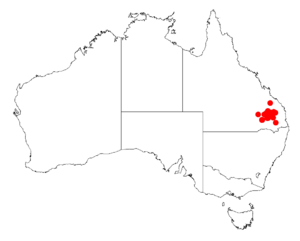Acacia tenuinervis facts for kids
Quick facts for kids Acacia tenuinervis |
|
|---|---|
| Scientific classification | |
| Genus: |
Acacia
|
| Species: |
tenuinervis
|
 |
|
| Occurrence data from AVH | |
Acacia tenuinervis is a type of shrub or small tree. It belongs to the large group of plants called Acacia, which are often known as wattles in Australia. This plant is found naturally in the northeastern parts of Australia.
About the Acacia tenuinervis Plant
This shrub or tree can grow up to 9 meters (about 30 feet) tall. It can also spread by sending out new shoots from its roots, which are called root suckers. The bark on its trunk is usually black to grey-brown and has deep grooves.
The younger branches are often orange-red or red-brown. They are covered with a fine white powder and can be a bit angled near their tips. As they get older, these branches become smooth (glabrous) and may have small flakes (scurfy).
Instead of typical leaves, most Acacia species, including this one, have special flattened stems called phyllodes. The phyllodes of Acacia tenuinervis are smooth and may have small flakes. They are shaped like a narrow oval, or sometimes like a sickle. They are usually between 6.5 and 12.5 centimeters (about 2.5 to 5 inches) long and 1.5 to 3 centimeters (about 0.6 to 1.2 inches) wide. Each phyllode has three to five main veins that stick out a little.
This plant blooms between August and September. It produces golden flowers that grow in cylinder-shaped spikes. These flower spikes are about 3 to 5 centimeters (about 1.2 to 2 inches) long.
After the flowers, seed pods form. These pods are thin, flat, and may have small flakes (scurfy). They are also somewhat papery (chartaceous). The pods are pinched in between the seeds and raised over them. They can be 2 to 11 centimeters (about 0.8 to 4.3 inches) long and 2 to 4 millimeters (about 0.08 to 0.16 inches) wide. Inside, the black seeds are arranged lengthwise. The seeds themselves are shaped like a long oval and are about 3.5 to 6 millimeters (about 0.14 to 0.24 inches) long.
How Acacia tenuinervis Was Named
This plant was first officially described in 1978 by a botanist named Leslie Pedley. A botanist is a scientist who studies plants. Pedley included his description in a scientific paper called A revision of Acacia Mill. in Queensland, which was published in a journal called Austrobaileya.
Later, in 1987, Pedley changed the plant's name to Racosperma tenuinerve. However, in 2001, it was moved back to the Acacia group, which is where it is known today.
Where Acacia tenuinervis Grows
Acacia tenuinervis is endemic to a few small areas in South East Queensland, Australia. This means it is found naturally only in these specific places and nowhere else in the world.
You can find it growing in areas like Glenmorgan, Boondooma, and Impey pastoral properties. It usually grows in gravelly soils that contain a lot of iron, called ironstone soils. It is often part of Acacia harpophylla scrub or open Eucalyptus woodland communities. These are types of forests or bushy areas where these specific trees are common.

